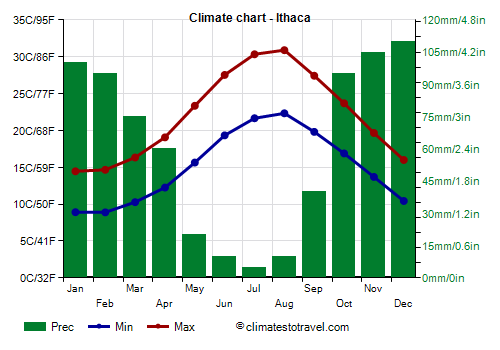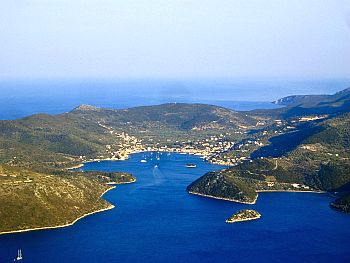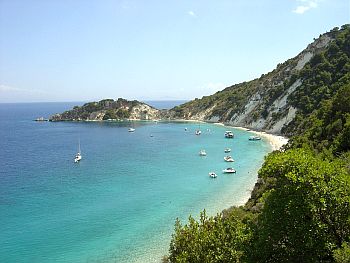Select units of measurement for the temperature and rainfall tables (metric or imperial).
Average weather, temperature, rainfall, sunshine hours

The climate of Ithaca, a Greek island of the Ionian Sea, is
Mediterranean, with mild, rainy winters and hot, sunny summers. At sea level, the daily average temperature ranges from 11.5 °C (52.5 °F) in January to 26.5 °C (79.5 °F) in August.
Here are the average temperatures (recorded in Argostoli, on the nearby island of Kefalonia).
Ithaca - Average temperatures (1991-2020) |
| Month | Min | Max | Mean |
|---|
| January | 8.9 | 14.5 | 11.7 |
|---|
| February | 8.9 | 14.7 | 11.8 |
|---|
| March | 10.3 | 16.3 | 13.3 |
|---|
| April | 12.3 | 19.1 | 15.7 |
|---|
| May | 15.6 | 23.4 | 19.5 |
|---|
| June | 19.3 | 27.5 | 23.4 |
|---|
| July | 21.7 | 30.3 | 26 |
|---|
| August | 22.3 | 30.9 | 26.6 |
|---|
| September | 19.8 | 27.4 | 23.6 |
|---|
| October | 16.9 | 23.7 | 20.3 |
|---|
| November | 13.7 | 19.7 | 16.7 |
|---|
| December | 10.4 | 16 | 13.2 |
|---|
| Year | 15.1 | 22 | 18.5 |
|---|
amounts to about 700 millimeters (27.5 inches) per year, and is concentrated in the period from October to April, while in summer, it rains very rarely. Here is the average precipitation.
Ithaca - Average precipitation| Month | Days |
|---|
| January | 100 | 13 |
|---|
| February | 95 | 13 |
|---|
| March | 75 | 10 |
|---|
| April | 60 | 10 |
|---|
| May | 20 | 5 |
|---|
| June | 10 | 2 |
|---|
| July | 5 | 1 |
|---|
| August | 10 | 2 |
|---|
| September | 40 | 4 |
|---|
| October | 95 | 10 |
|---|
| November | 105 | 13 |
|---|
| December | 110 | 14 |
|---|
| Year | 725 | 97 |
|---|
In the interior, there are hills, culminating in Mount Nirito, 800 meters (2,600 feet) high.
 Winter
Winter, from December to mid-March, is mild but rainy, especially in December and January, when 100/110 millimeters (40/43 inches) of rain fall per month. However, there is a moderate amount of sunny days as well. Sometimes, a cold wind from the north can blow, and the minimum temperature at sea level can drop to 0 °C (32 °F).
Spring, from mid-March to May, is mild; rainfall becomes gradually rarer over the weeks, and fine weather becomes more and more frequent. May is a good month, before the summer heat.
Summer, from June to mid-September, is hot and sunny: the maximum temperature often exceeds 30 °C (86 °F) and can even reach 35 °C (95 °F), especially in July and August; at the worst, it can reach 40 °C (104 °F). Luckily, sea breezes blow, providing relief, at least when the heat is not excessive, and in any case, you can cool yourself in the sea.
Autumn, from mid-September to November, is mild (and initially, even quite warm) and rainy. In October, there may still be many sunny days.

The amount of
sunshine in Ithaca is great in late spring and summer, when clear skies prevail, while from November to mid-March, sunny days alternate with periods of bad weather. Here are the average sunshine hours per day.
Ithaca - Sunshine hours| Month | Average | Total |
|---|
| January | 4 | 125 |
|---|
| February | 5 | 140 |
|---|
| March | 6 | 185 |
|---|
| April | 8 | 240 |
|---|
| May | 10 | 310 |
|---|
| June | 11 | 330 |
|---|
| July | 12 | 370 |
|---|
| August | 12 | 370 |
|---|
| September | 10 | 300 |
|---|
| October | 7 | 215 |
|---|
| November | 5 | 150 |
|---|
| December | 4 | 125 |
|---|
| Year | 7.9 | 2865 |
|---|
The temperature of the
sea in Ithaca is high enough for swimming from July to September, while in June, it is still a bit cool. Here are the average sea temperatures.
Ithaca - Sea temperature| Month |
|---|
| January | 16 |
|---|
| February | 15 |
|---|
| March | 15 |
|---|
| April | 16 |
|---|
| May | 19 |
|---|
| June | 22.5 |
|---|
| July | 25 |
|---|
| August | 26 |
|---|
| September | 25 |
|---|
| October | 22.5 |
|---|
| November | 20"> |
|---|
| December | 17.5 |
|---|
| Year | 20 |
|---|
Best Time
The
best time to travel to Ithaca for a beach holiday runs from June to mid-September.
If you want to go on excursions around the island, the month of May or the first half of October are preferable in order to avoid the heat that sometimes occurs in summer.
Back to the
Ionian Islands.